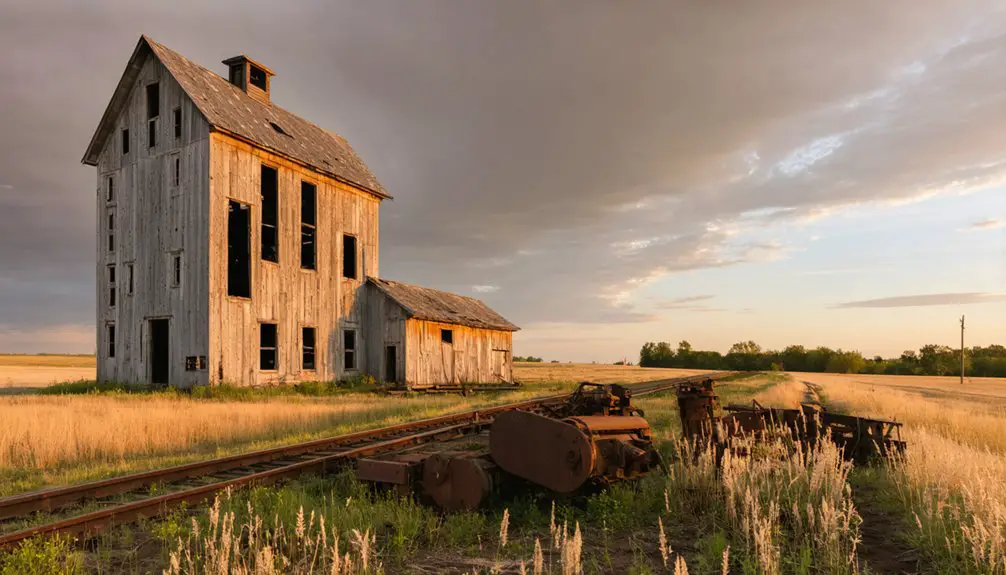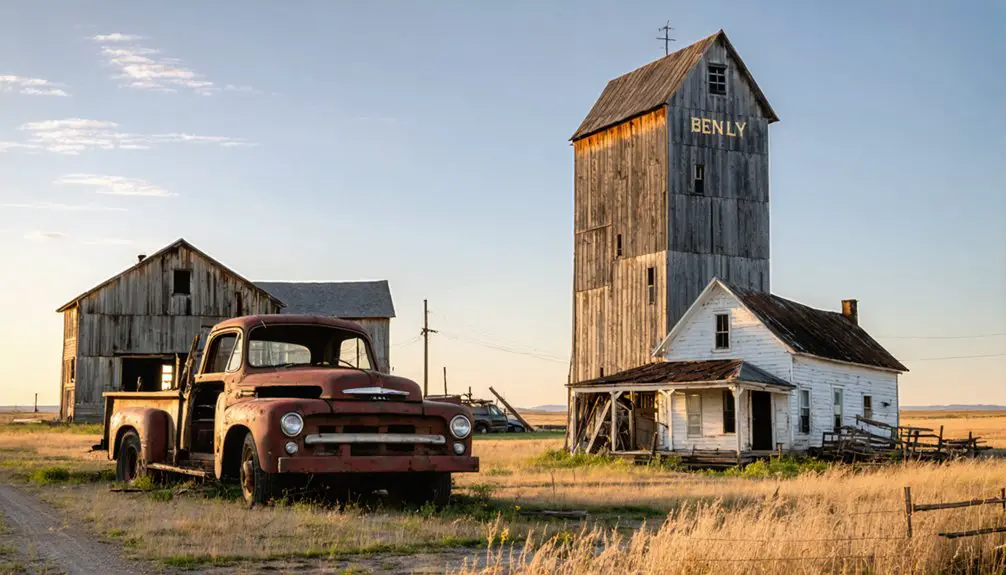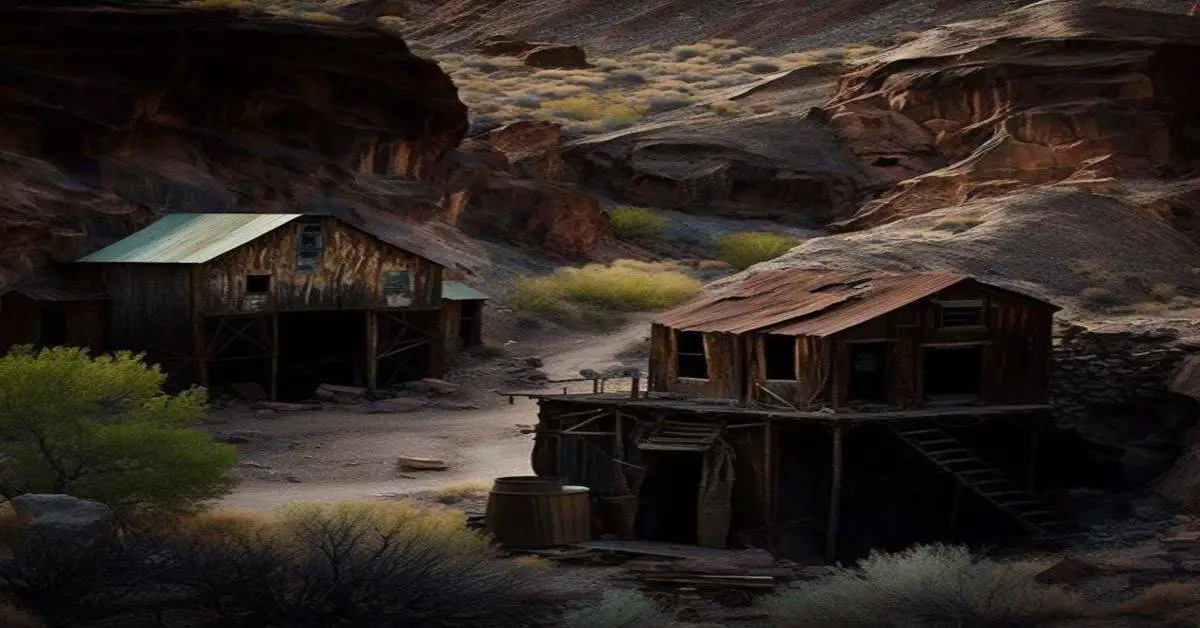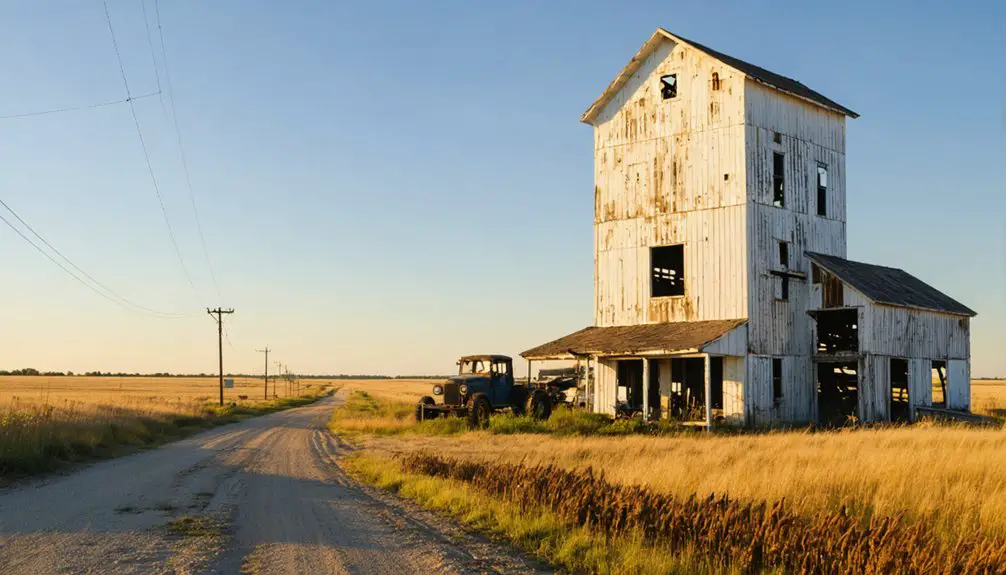You’ll find Bentley in Hettinger County, North Dakota, where it began as a pioneer settlement in 1906. The town relocated in 1915 and reached its peak with 200 residents, complete with a pool hall and post office. By 1960, modernization and urban migration reduced the population to just 51 people. Today, you can explore the deteriorating railway express building, storage sheds, and the historic iron cemetery gate that marks this prairie ghost town‘s fascinating past.
Key Takeaways
- Bentley, North Dakota was established in 1906 and relocated in 1915, reaching a peak population of 200 before declining to 51 residents by 1960.
- The town’s main architectural remnants include a deteriorating railway express building, storage sheds, and an iron cemetery gate marking its founding.
- Economic decline occurred due to railroad network changes, automobile adoption, and farm mechanization reducing the need for local workers.
- Ghost town tourism has transformed Bentley into a heritage destination, with local businesses offering crafts and hospitality services.
- The town features abandoned vehicles, farm equipment, and building foundations that reflect its early 20th-century agricultural and transportation heritage.
The Rise and Fall of a Pioneer Settlement
While many pioneer settlements dotted North Dakota’s landscape in the early 1900s, Bentley’s story began in 1906 when settlers established the town fifteen miles south of its eventual location. Similar to how disambiguation pages clarify multiple meanings of place names, historical records help distinguish this Bentley from others.
You’ll find that community resilience drove the town’s relocation in 1915 to better serve local needs, marking a pivotal moment in Bentley’s development.
The settlement thrived modestly, reaching about 200 residents at its peak. The town grew to include a pool hall and post office, which were operated by early resident Joe Kelsch.
You’d have seen a typical pioneer town centered around agricultural evolution, with farmers and ranchers supporting local commerce.
But by 1960, modernization took its toll. Mechanized farming reduced labor demands, while younger generations sought opportunities in larger cities.
The population plummeted to 51 residents, and transportation routes shifted away from Bentley, accelerating its transformation into a ghost town.
A Tale of Two Bentleys: Understanding the Distinction
How can two North Dakota towns share the same name yet follow entirely different destinies? The Bentley confusion stems from a unique historical twist: one Bentley, founded in 1879, later became Sanger in Oliver County, while another Bentley emerged in 1906 in Hettinger County.
You’ll find the first Bentley near the Missouri River, about 40 miles north of Bismarck, where it once served as a county seat until 1884. The second Bentley, initially established 15 miles south of its current location, relocated in 1915. Modern explorers frequently discover abandoned rail cars and vintage vehicles while documenting these historic locations.
Their historical significance differs markedly – Sanger became virtually abandoned with just two residents by 2023, while the 1906 Bentley maintained a small population of about 20 people into the 21st century. The original Bentley-turned-Sanger gained fame as the birthplace of local heroine Hazel Miner.
Life Along the Missouri River Banks
If you’d lived along the Missouri River in Bently’s early days, you’d have witnessed bustling riverboat traffic carrying supplies and settlers to emerging communities along the banks.
The river’s natural abundance provided early residents with fish, wild game, and fertile soil for farming, while steamboat landings served as crucial connection points for trade and transportation. The area supported numerous Indigenous peoples, with over ten tribes making their homes along these productive waters.
During the peak of river commerce, these landings weren’t just practical necessities – they were social hubs where travelers, traders, and locals exchanged news and goods, creating a vibrant riverside culture that defined life in settlements like Bently. The Mandan villages were particularly important trade centers due to their strategic position along these vital waterways.
River Trade Era
During the height of Missouri River trade in the 1800s, the waterway served as an essential commercial artery that shaped life near present-day Bentley, North Dakota.
You’d have seen steamboats like the Yellowstone revolutionizing cargo transport, connecting settlements to critical supply chains during ice-free months.
River trade dynamics influenced settlement patterns, as communities strategically positioned themselves along high bluffs and riverbanks.
The town celebrated its 50th anniversary in 1960, marking half a century since its official founding.
You’ll find evidence of this in how Native and early settler villages clustered near the water, maximizing access to both resources and trading opportunities.
Landing points along the Missouri’s banks became informal trading hubs where furs moved downstream and supplies arrived from eastern markets.
This network of river commerce sustained frontier communities until railroad expansion eventually diminished the waterway’s commercial importance.
The river’s dramatic landscape was shaped by ancient immense glacial floods that carved out the Missouri River valley and its distinctive features.
Early Riverboat Landing History
The arrival of the steamboat Yellowstone at Fort Union in 1832 marked a transformative moment for life along the Missouri River’s banks.
You’d have witnessed a dramatic shift in riverboat navigation as steamboats replaced keelboats, carrying heavier cargo loads and pushing further upstream against the current. These vessels operated during ice-free months, establishing essential supply lines for early settlements.
The river’s natural features shaped where people lived and traded. You’ll find evidence of this in the indigenous villages that once dotted the high bluffs, strategically positioned for defense and river access.
These communities built complex earthworks and ditches, taking advantage of fertile riverbank soil for farming. The steamboat landings you’d encounter weren’t just transport hubs – they became important social centers that connected diverse communities along the Missouri. The construction of Garrison Dam in the 1950s forever altered this river valley way of life, forcing entire towns to relocate.
Missouri’s Natural Resources
Life along Missouri’s riverbanks once teemed with extraordinary biodiversity, supporting vast networks of native species across ten states and two Canadian provinces.
Today, you’ll find a drastically altered ecosystem, with three million acres of natural river habitat transformed by human activity. River conservation efforts face sobering statistics: 76% of native fish species are now declining or rare, and aquatic insect populations have plummeted by 70%. The region’s outdoor recreation activities contribute to an impressive annual $8.9 billion in wildlife-associated expenditures.
You can witness the ongoing habitat restoration work led by the Missouri River Natural Resources Committee, which coordinates preservation across seven states.
They’re fighting to protect endangered species like the pallid sturgeon and piping plover while working to reconnect floodplains and restore native vegetation.
Despite these challenges, the river remains essential, providing drinking water for millions and supporting outdoor recreation industries.
From County Seat to Ghost Town

Founded in 1879 as Bentley before being renamed Sanger, this once-promising settlement served as Oliver County’s seat of government until 1884.
You’ll find its location about 40 miles north of Bismarck, strategically positioned near the Missouri River’s west bank. While its role as county seat suggested early promise, the town never achieved substantial growth.
The loss of its administrative status marked the beginning of a long decline. Like many rural North Dakota communities, Sanger couldn’t sustain its population against the tide of rural exodus throughout the 20th century.
The Legacy of Hazel Miner
Among Sanger’s most enduring legacies stands the heroic story of Hazel Miner, a 15-year-old girl who sacrificed her life to save her siblings during a devastating blizzard in 1920.
You’ll find her spirit lives on through the monument in Center, North Dakota, where a statue commissioned by Governor L. B. Hanna honors her extraordinary courage.
When their horse-drawn sleigh became lost in white-out conditions, Hazel’s heroism shone through as she wrapped her younger siblings in blankets and lay on top to shield them from the fierce wind.
Throughout that brutal night, the strength of their sibling bond was tested as she kept Emmet and Myrdith awake, urging them to move and stay alive.
Though Hazel didn’t survive, her sacrifice guaranteed her siblings did, cementing her place in North Dakota’s cultural memory.
Architectural Remnants and Historical Markers

If you visit Bentley today, you’ll find minimal architectural remnants from its early 20th-century heyday, with only the deteriorating railway express agency building and a few storage sheds still standing.
The site’s most prominent historical marker is a simple directional sign along the nearby highway, pointing travelers to what remains of this former railway town.
While no official commemorative plaques exist onsite, the skeletal frameworks of railway-related structures serve as silent historical markers, documenting Bentley’s connection to the Great Northern Railway.
Standing Structures Today
Today, only a handful of structures remain in the ghost town of Bentley, North Dakota, with two houses still standing but marked as no trespassing.
You’ll find these remnants of architectural preservation amid scattered ruins of abandoned homes, many succumbing to roof collapse and natural decay. While exploring this ghost town, you’ll notice abandoned vehicles and farm equipment that hint at the community’s agricultural heritage.
The town, which once housed 200 residents, has seen most of its buildings fade into the landscape since the 1960s population decline.
Though no churches or community buildings remain prominently standing, you can trace old road patterns and pathways between existing structures. The harsh climate and decades of exposure continue to take their toll on these final witnesses to Bentley’s past.
Historical Marker Locations
Standing prominently at the town’s entrance, Bentley’s iron cemetery gate serves as the primary historical marker, documenting the town’s 1906 founding and subsequent 1915 relocation.
You’ll find additional markers scattered throughout the site, typical of North Dakota ghost towns, highlighting the cultural heritage of this once-thriving community.
The marker significance extends beyond the cemetery gate to include foundations of former commercial buildings and remnants of transportation infrastructure that shaped Bentley’s development.
Throughout the area, you’ll discover architectural traces that tell the story of early 20th-century settlement patterns, including abandoned homesteads and farm outbuildings.
The State Historical Society maintains records of these markers, preserving the legacy of towns like Bentley that played vital roles in North Dakota’s agricultural and railway expansion.
Transportation Routes and Economic Changes
As railroad networks evolved throughout North Dakota in the early 20th century, Bentley’s fate became intertwined with the changing transportation landscape that reshaped America’s rural communities.
You’ll find that the transportation evolution hit small towns like Bentley particularly hard, as the rise of automobiles in the 1920s allowed residents to bypass local shops in favor of larger commercial centers.
The economic decline accelerated when mechanization reduced the need for farm workers, and improved highways made it easier to reach distant markets.
You could see the impact as local grain elevators closed, “Mom and Pop” stores shuttered, and post offices consolidated operations.
Like many railroad-dependent settlements, Bentley couldn’t sustain itself once the transportation patterns shifted and agricultural practices modernized.
Population Shifts Through the Decades

When Bentley first emerged in 1879, the settlement quickly drew nearly 100 Polish immigrant families who established roots in and around the community, then known as Sanger.
You’d have found a bustling small town during its early years as the county seat, with local businesses, grain elevators, and schools serving the tight-knit farming community.
The town’s population peaked in the early 1900s, likely reaching around 150 residents, similar to neighboring Blabon.
But you’ll see how population migration patterns shifted dramatically during the 1930s, as the Dust Bowl and Great Depression drove families toward urban centers like Bismarck.
This economic decline continued relentlessly through the mid-century, with farm consolidation and lost services hastening the exodus until Sanger’s complete abandonment by 1985.
Preserving Local Heritage and Memory
Today’s preservation of Bentley’s heritage rests heavily on archival documentation and community-driven initiatives.
You’ll find the North Dakota Historical Society’s newspaper archives and courthouse records provide the most reliable historical data, while oral histories from locals add rich cultural context.
Community storytelling plays an essential role through reunions and historical society meetings, where former residents share memories that might otherwise be lost.
Cultural documentation efforts include photographic projects, digital archives, and virtual tours that make Bentley’s history accessible to wider audiences.
While deteriorating structures and limited funding pose challenges, you can explore the town’s heritage through interpretive signage, museum collaborations, and media projects.
Local artists and historians work together to create exhibitions that keep Bentley’s unique story alive for future generations.
Modern-Day Ghost Town Tourism
Ghost town tourism has transformed Bentley into a distinctive heritage destination that draws visitors from across the Midwest.
You’ll find carefully marked trails and interpretive signs that guide you through the town’s historic structures, while guided tours offer safe access to otherwise restricted areas.
The town faces typical ghost town tourism challenges, including the need to upgrade access roads and visitor facilities without compromising the site’s authenticity.
You can experience new interactive elements, like digital storytelling apps, that bring Bentley’s past to life.
Local businesses have emerged to support tourism, offering crafts and hospitality services that boost the seasonal economy.
When you visit, you’re participating in a carefully balanced approach to preservation that protects Bentley’s heritage while creating sustainable economic opportunities for the surrounding community.
Frequently Asked Questions
What Types of Wildlife Now Inhabit the Abandoned Buildings of Sanger?
You’ll find bats, rats, and feral cats making their homes in Sanger’s abandoned wildlife havens. During urban exploration, you’ll spot owls, pigeons, and numerous insects thriving in the ruins.
Are There Any Paranormal Activity Reports Associated With the Ghost Town?
Like a broken smartphone in 1906, there’s no signal when it comes to haunting tales here. You won’t find documented ghost sightings – the paranormal activity reports are nonexistent in available records.
Can Visitors Legally Explore and Photograph the Remaining Structures?
You’ll need explicit permission from property owners before exploring structures, as most are on private land. You can photograph from public roads, but respect posted signs and exploration guidelines.
What Happened to the Original Town Records and Documents?
You’ll find many original town records scattered between county courthouses and historical societies, though some were lost forever when Bentley’s administrative functions ceased and buildings fell to neglect and time.
Did Any Famous People Besides Hazel Miner Come From Bentley/Sanger?
Besides Hazel Miner, you won’t find other famous local legends or historical figures from Bentley/Sanger. Dr. William Bentley practiced medicine nearby, but he wasn’t from these specific towns.
References
- https://en.wikipedia.org/wiki/Sanger
- https://ghostsofnorthdakota892857007.wordpress.com/2007/05/28/bentley-nd/
- https://northernsentry.com/2023/05/12/ghosts-of-north-dakota/
- https://www.youtube.com/watch?v=MZ_xZ0d_TBY
- https://ghostsofnorthdakota892857007.wordpress.com/category/bentley-nd/
- https://en.wikipedia.org/wiki/History_of_North_Dakota
- https://commons.und.edu/cgi/viewcontent.cgi?filename=9&article=1000&context=oers&type=additional
- https://www.history.nd.gov/ndhistory/settlement.html
- https://en.wikipedia.org/wiki/Missouri_River
- https://www.mhanation.com/history



